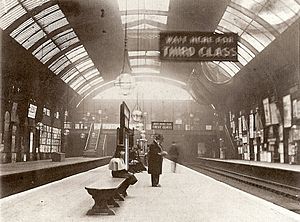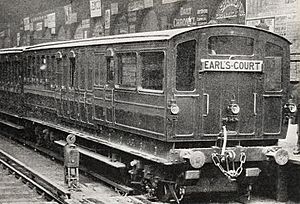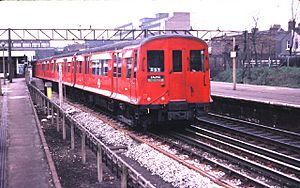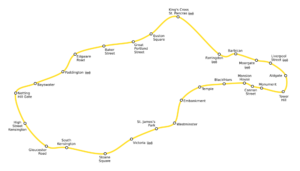Circle line (London Underground) facts for kids
| Colour on map | Yellow |
| Year opened | 1949 |
| Line type | Sub-Surface |
| Rolling stock | C stock S stock |
| Stations served | 36 |
| Length | 27 km (17 mi) |
| Depots | Hammersmith |
| Journeys made | 114.6 million (2011/12) |
The Circle line is a famous part of the London Underground, also known as the Tube. You can spot it easily on the Tube map because it's coloured yellow. It's one of the busiest lines, carrying many passengers every year. The Circle line goes in a big loop around the middle of London, mostly north of the River Thames.
Contents
History
How it Started
The story of the Circle line began in 1863. That's when the Metropolitan Railway opened in London. It ran between Paddington and Farringdon. This was a huge deal because it was the world's very first underground railway! It helped connect major train stations like Paddington, Euston, and King's Cross to the City of London, which is London's financial centre.
Soon after, people started talking about building an "inner circle" of railway lines. This would connect all the main train stations in London. In 1864, the Metropolitan District Railway (also called the District Railway) was created. Its job was to build a railway from South Kensington to Tower Hill.
Over the next few years, both the Metropolitan and District railways kept building their lines. By 1884, after some disagreements between the two companies, the "inner circle" was finally finished. This meant trains could now travel in a full loop around central London. The Metropolitan Railway ran trains clockwise, and the District Railway ran them anti-clockwise.
Other Loop Routes
Besides the main inner circle, there were other railway lines that went around London. These were not full loops like the Circle line. For example, the London and North Western Railway had an "outer circle" service. The Great Western Railway also had a "middle circle" service. Most of these services were shortened over time. Today, the London Overground runs similar services that go around parts of London.
Electric Trains Arrive
When the underground railways first opened, trains were pulled by steam locomotives. This made the stations and carriages very smoky, which passengers didn't like! At the start of the 1900s, new electric underground lines and trams were becoming popular. So, the District and Metropolitan railways decided they needed to switch to electric trains.
They started testing electric trains between Earl's Court and High Street Kensington. In 1900, a special six-carriage electric train began carrying passengers. At first, they planned to use an "AC" (Alternating Current) system. However, an American investor named Charles Yerkes got involved. He preferred a "DC" (Direct Current) system, which was used on other electric lines in London. After some debate, the DC system was chosen.
The railways then started changing their tracks and buying new electric trains. The District and Metropolitan Railways bought different types of electric trains. Full electric service on the Circle line began on 24 September 1905. At first, trains had 6 carriages, but this was later changed to 4. Over the years, trains were updated, and more carriages were added.
London Transport Takes Over
On 1 July 1933, many of London's transport companies, including the Metropolitan and District Railways, joined together. They formed a new group called the London Passenger Transport Board. This group managed all the Underground railways, trams, and buses.
The electric trains used on the Circle line were updated. They were painted red and cream, and later just red. From 1947, newer trains called "O and P Stock" were used. These trains had doors that the guard could open and close from a distance.
On older maps, the Circle line wasn't shown as its own line. It was part of the Metropolitan and District lines. But in 1949, the Circle line finally appeared as a separate yellow line on the Tube map!
In the 1950s, Circle line trains were made longer, with 6 carriages. From 1970, new, unpainted aluminium trains called "C Stock" were introduced. These trains even had public address systems so drivers could talk to passengers. In 1984, trains started to be operated by just one person, the driver, instead of a driver and a guard.
The Line Changes Shape
For a long time, the Circle line was a simple loop. Trains just went around and around in both directions. It had 27 stations and was about 20.75 kilometres (12.9 miles) long.
But on 13 December 2009, the Circle line was changed. It was extended to include the Hammersmith & City line route from Edgware Road to Hammersmith. Now, trains don't just go in a continuous loop. Instead, they travel from Hammersmith to Edgware Road, usually go around the circle once, and then end their journey at Edgware Road. They then return on the same route. This change was made to make the service more reliable and to have more trains running on the Hammersmith part of the line.
Newer trains, called "S7 Stock," started running on the Circle line in 2013. By June 2014, all trains on the line were these modern S7 Stock trains.
See also
 In Spanish: Circle Line para niños
In Spanish: Circle Line para niños





